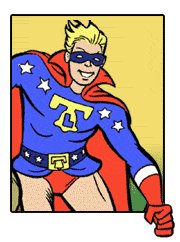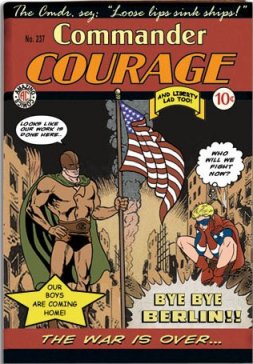| The
Naked Censorship of Liberty Lad
Just
in case you've forgotten, we're working in conjunction with
Donald Swan on bringing his classic 'zine Once Upon A Dime
to the web. Today, the online version has posted this article
from the July 1976 issue.
Don
has given me permission to post part of the article here;
if you like it, please follow the link over to our sister
site, onceuponadime.com.
Thanks.
Enjoy.
Though
his own courage shortened his career in comics, Jackson Whitney
had a keen grasp of what the burgeoning superhero field would
need. In the very first Commander Courage story, "The Origin
of Commander Courage," Whitney had fleshed out polio-stricken
junior high school teacher Jefferson Dale's supporting cast.
No mere crutches these, the staff and students of Nathan Hale
Junior High would each and every one prove to be crucial to
the mythos of Commander Courage.
None
moreso, perhaps, than Alexander "Dusty" Dale, Jefferson's
nephew and ward. Despite the already popular presence of figures
like Robin, The Boy Wonder, in Whitney's friend Bob Kane's
strip Batman, the doomed but brave comics creator originally
intended this all-American boy to be just that: an all-American
boy. Red-blooded and true blue, Dusty Dale was something every
schoolboy could aspire to be, and I don't just mean an Eagle
Scout.
Devoid
of superpowers, Dusty had heart. Ignorant of his uncle's heroic
secret identity, Dusty still fought the good fight on the
home front by example.
It's
quite likely that that very example led to the extreme scarcity
of the third issue of Commander Courage, for that featured
the classic story in which Dusty spearheaded the Nathan Hale
Junior High war paper drive. What kid could hold onto that
comic book when Dusty had made it clear that saving comics
was just playing right into Axis hands? Our boys in Europe
and the Pacific needed that paper.
When
finally, nine months after the strip's creation, Whitney finally
gave in and turned the youth into another teen sidekick in
the superhero canon, it was perhaps a bit of wish fulfillment
on his part. A justification, if you will, of the artist's
desire to fight for his country himself, not just with the
scathing power of pen and ink.
For of
course, Liberty Lad would prove to be Jackson Whitney's last
creation, an act of pulp patriotism to inspire young men everywhere
just before Whitney became a doughboy and fell lifeless somewhere
in the Forests of Ardenne.
As such,
what was done to Liberty Lad by small-minded men is nothing
less than a crime, a dark moment in the comics industry's
past that sadly, few seem to care about today.
In late
1941, comics were still seen as something for kids, though
many adults did read them. But they had an innocence, reflective
of the time and America's willingness to still see the best
in humanity in the face of great evil. Jackson Whitney had
that innocence, too, and poured it into Liberty Lad.
By now,
the origin of the fair-haired streak of liberty has almost
become the stuff of cliché. And indeed, in later years, Julius
Schwartz would borrow heavily from Whitney's classic story
to allow Wally West to become Kid Flash, though to this day
he denies the homage.
The story
refers to "the dark winter of 1942," clearly meant to resonate
with the anniversary of the day Dusty lost his father at the
treacherous attack on Pearl Harbor. The plucky orphan visits
his uncle at the Liberty Bell museum, where he finds the older
man has recreated the very situation that gifted him with
the "Mega-will" that makes him Commander Courage.
Meaning
to provide Dusty with some inspiration, Jefferson Dale intones
the oath he had taken on December 7, 1941, when lightning
strikes twice!
The Liberty
Bell tumbles from its moorings, causing Jefferson to spill
the Indian Shaman Waters he carries with him at all times
in memory of his Native American friends. Mixing with the
electrical charge of lightning and amplified by the conducting
power of the Bell, the water splashes onto a frozen Dusty
Dale, who suddenly finds himself possessed of the quasi-mystic
Mega-will.
 (Purists
will note that this is not an exact recreation of Jefferson's
original transformation; perhaps Jackson Whitney felt that
the presence of the actual Shaman Mystics a second time would
have been too coincidental. Alas, we will never know, but
it seems like a prudent choice on his part and thus, a safe
conclusion to reach. Besides, comics creators rejiggered origins
all the time, ignoring elements they found difficult to revisit.
Witness Jack Cole's modest retooling of Lev Gleason's original
red and blue Daredevil within six months of the character's
first appearance.) (Purists
will note that this is not an exact recreation of Jefferson's
original transformation; perhaps Jackson Whitney felt that
the presence of the actual Shaman Mystics a second time would
have been too coincidental. Alas, we will never know, but
it seems like a prudent choice on his part and thus, a safe
conclusion to reach. Besides, comics creators rejiggered origins
all the time, ignoring elements they found difficult to revisit.
Witness Jack Cole's modest retooling of Lev Gleason's original
red and blue Daredevil within six months of the character's
first appearance.)
At any
rate, now armed with the same abilities as his uncle and soon
to be superhero mentor, Dusty Dale dons the famous star spangled
top and trunks of Liberty Lad for the first time.
Wait
a minute. Trunks, I said? But we know Liberty Lad, and he
wears tightly cut breeches, not trunks, you say.
Prepare
yourselves for a shock. Up until 1953, Dusty Dale went bare-legged,
just like a few other boy wonders. It was only the terrible
but understandable cowardice of the editor at Amazing Comics,
Delmer McNeal, that caused the change. So deep was his shame
that any comics reprinting pre-1953 stories corrected the
art to bury Liberty Lad's original costume.
Yes,
1984 came early to comics.
For
the rest of the article, click here...
|

 (Purists
will note that this is not an exact recreation of Jefferson's
original transformation; perhaps Jackson Whitney felt that
the presence of the actual Shaman Mystics a second time would
have been too coincidental. Alas, we will never know, but
it seems like a prudent choice on his part and thus, a safe
conclusion to reach. Besides, comics creators rejiggered origins
all the time, ignoring elements they found difficult to revisit.
Witness Jack Cole's modest retooling of Lev Gleason's original
red and blue Daredevil within six months of the character's
first appearance.)
(Purists
will note that this is not an exact recreation of Jefferson's
original transformation; perhaps Jackson Whitney felt that
the presence of the actual Shaman Mystics a second time would
have been too coincidental. Alas, we will never know, but
it seems like a prudent choice on his part and thus, a safe
conclusion to reach. Besides, comics creators rejiggered origins
all the time, ignoring elements they found difficult to revisit.
Witness Jack Cole's modest retooling of Lev Gleason's original
red and blue Daredevil within six months of the character's
first appearance.)





